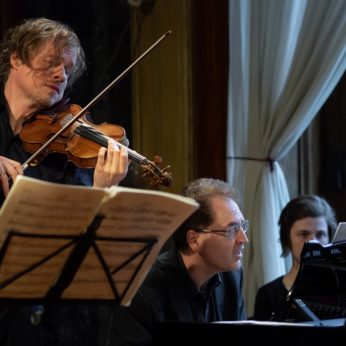Composer: Edvard Grieg (b. 1843 - d. 1907)
Performance date: 04/07/2019
Venue: Bantry Library
Composition Year: 1886-7
Duration: 00:23:32
Recording Engineer: Ciaran Cullen, RTÉ
Instrumentation: vn, pf
Instrumentation Category:Duo
Artists:
Henning Kraggerud -
[violin]
Dénes Várjon -
[piano]

Edvard Grieg [1843-1907]
Violin Sonata No.3 in C minor Op.45 [1886-7]
1. Allegro molto ed appassionato
2. Allegretto espressivo alla Romanza – Allegro molto – Tempo I
3. Allegro animato
Grieg’s marriage to his cousin Nina Hagerup, later a famous singer, suffered dramatic upheavals in the ten years before this Sonata was composed. Their blissful early years, so brilliantly caught in in his G major Violin Sonata, were cruelly cut off by the sudden death of their daughter when only one-year-old and the realisation that Nina could not bear any more children. Grieg threw himself into his career as composer, conductor and pianist and soon created a role for himself as a national figure. Despite his success the composer began to be plagued with doubts about music, religion, marriage and three years before this sonata made an attempt to escape to Paris to join the Norwegian artist, Leis Schjelderop, whom he had known in Bergen. The attempt failed and he was reeled back in to join Nina in a life on the road, the building of their now famous house at Troldhaugen and his role as Norway’s pre-eminent composer.
Right from the brutal opening we are hurled into a dizzying onslaught of dark and passionate themes,
where every tranquil moment has to be fought for. Grieg’s first two subjects, which sound so different, are carved from the same rock, rooted in the opening motif, though the second subject at first sounds almost gentle before it too gathers pace and storms the heights. In the development the music seems to stall briefly, as if in the eye of the hurricane, before the savagery of the opening insists on its space and the magnificent return of the first subject. For a moment in the coda it seems lyricism, over the arpeggiated chords heard early in the development, might triumph but the mood again darkens and the movement ends with thunder.
That grim, dissonant close contrasts all the more effectively with the light-filled melody in E major which opens the slow movement – one of Grieg’s happiest inspirations, and he was not a man short of happy inspirations. But the light soon darkens into brooding atmosphere of the central section that contrasts so starkly with its outer panels that once again the thematic interconnections are effectively disguised.
Grieg builds the Finale from two sections which are then repeated—the development is dispensed with entirely. It opens with the violin stomping out a march-rhythm over the piano’s broken chords before the instruments begin an increasingly furious exchange of ideas. Eventually the pace slackens enough for the second theme to inch forward, a broad, yearning tune that begins low in the violin and gradually climbs upwards, falling back to allow the opening march-rhythms to resume. The Prestissimo coda transforms the aggressive opening theme into an exultant C major affirmation, swirling breathlessly to the close.
Francis Humphrys
Copyright © 2024 West Cork Music. All rights reserved.
Designed and developed by Matrix Internet